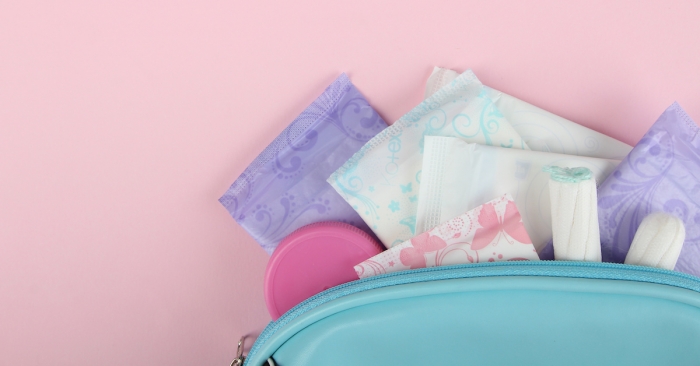Feminine hygiene product options have grown over the years. Many women remember when disposable pads and tampons were the only options. Some may remember further back when there was no such thing as an applicator on a tampon and pads didn’t have adhesive. But things change.
Whether you are reevaluating your hygiene needs or are helping a young person who is just entering her reproductive years decide which product is right for them, you might want to brush up on what is available. The Center for Young Women’s Health aims to educate young women on issues affecting them, including menstrual hygiene but can be a useful resource if you’re curious about the ins and outs of the variety of feminine hygiene products available today.
Menstrual Pads
Menstrual pads are placed in the underwear to catch and absorb blood once it leaves the vagina. Most pads do this with an adhesive that sticks to the underwear but can be peeled off easily for disposal. Menstrual pads are available in a wide range of sizes and lengths to accommodate different levels of menstrual flow and women of varying sizes. They can be very thin and referred to as a “panty liner” or thicker and more absorbent (sometimes called a “maxi pad”). Young girls just starting their menstrual cycles may feel more comfortable with an external menstrual pad rather than an internal product like a tampon.
Traditional menstrual pads that you buy in drug and grocery stores are disposable and must be thrown away after use. This means they create a significant amount of waste, which makes them unpopular among some eco and/or health-conscious women. Additionally, we’re learning that the cotton and rayon used in most menstrual pads are bleached and may contain unknown chemicals.
If you prefer external absorption over an internal product, there are options that are friendlier to your body and the environment. Natural, organic, and unbleached cotton pads have become more widely available in recent years.
Another option is a reusable cotton pad that is used the same way as a regular pad but is washed and dried after each use to be reused later. The reusable pad usually has a liner to absorb the menstrual blood and a holder to attach it to underwear. The liner is washed by hand or in the machine so it can be used over and over. These pads also come in different sizes and absorbencies and are available with organic cotton. You can find options for reusable cotton pads online.
Tampons
One of the most common and popular types of feminine hygiene products is the tampon. This internal hygiene product is inserted into the vagina to absorb menstrual blood. Some women prefer tampons to pads because the blood is absorbed internally, making less of a mess if changed with the right frequency. Many women also feel more comfortable exercising, playing sports, and swimming with an internal product like a tampon. Tampons are widely available in stores and some public bathrooms have dispensers that sell them, though this practice is declining.
Tampons are usually made of cotton, rayon, or a combination. They can come with applicators to help with insertion or without an applicator which requires insertion using the fingers. Applicators can be made of plastic, cardboard, or other plant-based material.
Tampons come in different sizes, or absorbencies, to accommodate different levels of menstrual flow. Like menstrual pads, tampons are disposable and should not be flushed down the toilet, especially in septic systems. Because they are single-use and disposable, they are not considered eco-friendly.
There has been some concern, especially in recent years, expressed about chemicals present in tampons and their possible effects. Because the tampon is inserted into the vagina, concerns about exposure to unknown chemicals are even greater than with menstrual pads. Due to these increased concerns, there are many organic and unbleached tampons on the market. You can find natural and organic brands at larger supermarket chains, drug stores, natural food stores, and online. Some companies offer recurring subscription services so you can have the products sent to you each month so you won’t be caught without supplies when your period comes.
It’s also important to note that there is an extremely small risk of a condition called toxic shock syndrome (TSS) when using tampons, but it is minimal.
Menstrual Cups
Menstrual cups are a form of internal period products that are used in place of tampons. Rather than absorb blood like a tampon, a menstrual cup collects and contains menstrual blood to prevent it from exiting the vagina. To dispose of the blood, the user pulls on a tab to remove the cup and pour out the blood, usually into a toilet. A menstrual cup is usually made of medical-grade silicone or rubber safe for inserting into the vagina. The flexible material makes it possible for the cup to be folded and inserted.
Most menstrual cups are reusable, meaning users can cleanse them between uses and keep them for many menstrual cycles before replacement is necessary. If you take proper care and cleanse them properly, they can last for years. This makes them an eco-friendly option for those looking for an alternative to tampons. Also, they are not linked to toxic shock syndrome (TSS) in the same way tampons are.
There can be a learning curve when switching from disposable feminine hygiene products to the menstrual cup, but many women swear by them and say it is worth figuring out. The cups come in different sizes based on flow and whether you’ve given birth vaginally. Popular brands include the DivaCup, Moon Cup, and many others.
Period Panties
A new alternative to disposable feminine hygiene products is the period panty. These specially made underwear are designed to absorb menstrual blood without the aid of a disposable cotton pad. The crotch of the panties is reinforced with four layers of material, which will absorb light or medium flows.
Some women prefer to wear these in conjunction with a tampon rather than regular underwear with a safety panty liner and some women feel comfortable only wearing the underwear. The fabric is designed to be leak-proof, odor resistant, non-staining, and completely washable.
One drawback to period panties is that they are costly, with the higher-rated brands being about $30 per pair. However, there are often deals or coupons you can use and because they are completely washable and reusable, they will eliminate waste and replace the disposable pads that you are currently buying.
Thinx is the brand most commonly associated with period panties as they popularized the product, but versions from other companies like Knix are also available.
About Raleigh OB/GYN
At Raleigh OB/GYN, we are happy to answer any questions you might have about your menstrual cycle, including which feminine hygiene products might be best and safest for you. We can be reached at 919-876-8225 or you can request an appointment online.


